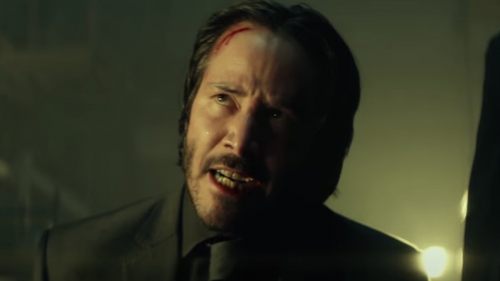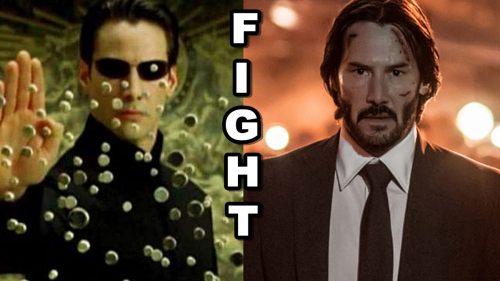Nevermind The Bollocks, CONSTANTINE Rules
John Wick: Chapter 2 is right around the corner (buy your tickets here). Which can only mean one thing. That's right. It's John Wick Week!
Let’s get something out of the way first – with its talk about deportation of illegal entities and a sub-plot about a demonically-possessed Mexican who jumps a border fence in order to bring about the end of the world, there’s a very good chance that Constantine is a favorite film of President Trump. But who can blame him? It’s a damn good movie.
Frances Lawrence directs this loose adaptation of the popular DC/Vertigo comic book title Hellblazer. The comic, one of the longest running from DC’s line of adult-oriented funny books, followed the adventures of John Constantine, a con man who partook in occultism and occasionally acted as Swamp Thing’s sex avatar when the green muck monster wanted to make love to his lady friend. The character was created by Alan Moore during his tenure on The Saga of the Swamp Thing when his artists, Steve Bissette and John Totleben, asked Moore to let them draw a character that looked like Sting, the frontman for The Police. John Constantine is known for his blonde hair, love of trenchcoats and cigarettes and a thick British accent. In fact, it’s this British accent that, I truly believe, paved the way for so many comic book fans to try and adopt such colorful phrases as “bollocks” and “bloody” into their vocabulary. If you’ve ever had a guy in a Flash t-shirt call you a bloke, it’s because of Hellblazer.
With all these traits in mind, naturally Hollywood went to the one actor that would best personify John Constantine – Keanu Reeves. In retrospect, it makes perfect sense. The film was released in 2005, only a couple of years after The Matrix trilogy had come to a close, and Warner Brothers was in the market for a new franchise for Keanu to make his own. And who can blame them? Despite the penchant of some elements of fandom to tease Keanu Reeves, the guy has shown time and time again he can carry an action movie, especially one that allows him to straddle the line between being moody and introspective and having the ability to blow people’s heads to smithereens with some kind of heavy duty weaponry.
While maybe Warner Brothers had to take a few liberties with the comic book property, at the time the character of John Constantine was very much a cult favorite – not having yet crossed over to mainstream awareness. For the majority of American audiences, nobody was going to know that Keanu Reeves did not resemble the traditional artistic representation of John Constantine, let alone that the movie was based on a comic book. Look at the success Marvel Studios achieved with Guardians of the Galaxy, a movie that bears little to no resemblance to the comic books it is based on.
Unfortunately, in the end, Constantine was not Guardians of the Galaxy. It was barely The Watcher. In its first weekend, the film opened second behind Hitch, the Will Smith romantic comedy, in its second week. The movie failed to find its audience and quickly left theaters – dashing any hopes the studio might have had for sequels, spin-offs and lucrative merchandise tie-ins. Imagine the Constantine-branded nicotine patches!
It’s a shame, though – because Constantine is actually really good. Released relatively early in the new age of super hero films we’re currently living in, Constantine is a perfect example of how to tell a character’s origin, feature a rip-roaring adventure with a ton of side characters familiar to the comic book mythos and have a close-ended resolution that offers a real arc for the hero. This isn’t a movie meant to set up a sequel, concerned only with paving the foundation for a franchise. It tells a solid done-in-one adventure that still manages to summon that buzziest of buzz words: “world building”
Reeves’ Constantine is a Los Angeles-based occultist, assisting in exorcisms in an effort to redeem his soul. Constantine was born with the ability to see the supernatural world that exists around humanity. Heaven and Hell are parallel dimensions, existing on top of our own. Occasionally, glimpses of the afterlife sneak through onto our plane – and, as a kid, Constantine could see the demons and angels that co-existed alongside humanity. Unfortunately, these visions were too much for a kid to handle and he took his own life. Thanks to modern medicine, Constantine’s suicide wasn’t a success – he was resuscitated but, according to Catholicism, his soul was forever damned due to his actions. The moment he died again, Constantine’s soul belonged to Hell. What’s a guy to do now that he knows for a fact Heaven and Hell are real and God is miffed at him? He becomes a leading expert in occultism and spends the rest of his life deporting demons who break the rules.
During a routine exorcism, Constantine begins to see clues that point to something strange and unprecedented happening in the world of Hell – demons are no longer content with using humans as meat puppets, they’re trying to cross over into the world. This is all part of a plot involving angels, demons, voodoo priests and twin psychics (played in a duel role by Rachel Weisz). The movie is positively crammed with plot – moving along at a kinetic pace that never leaves audiences bored. The film has the energy of a Saturday morning cartoon, but the style of an early ‘00s fantasy noir. It may be trying to evoke Phillip Marlowe by way of The Exorcist but this is a comic book movie through and through.
Director Francis Lawrence delivers a wonderful looking movie – alternating between muted colors that represent the mundane nature of Constantine’s blue collar occultism and rich, vibrant pulpy visuals as the film gets further and further into the fantastical. While the film does feature a lot of CGI, it also features great monster designs and make-up effects by the late Stan Winston and his crew. The film’s design work in general needs to be praised – it imagines Heaven and Hell as light and dark reflections of Los Angeles. As Constantine descends into Hell, the city decays around him, peeling away as it’s licked by flames. Heaven is represented by gleaming skyscrapers, nestled in clouds.
Keanu Reeves proves game for the role – bringing the sly sense of cynicism that we have come to expect from our antiheroes. The role allows Reeves to embrace the restrained, quietly smoldering bad boy image he’s built a career out of. He’s cheeky, a bit sarcastic and has long extended sequences in which he holds a cat. Is it any wonder this film has such a large female fan base?
Surrounding Reeves is an outstanding supporting cast that includes Tilda Swinton as an androgynous angel with a killer fashion style and a vestigial sense of compassion, Peter Stormare as one of the creepiest Satans to ever appear on film (he has neck tattoos and feet dripping with tar!), and Rachel Weisz, who rises above an admittedly thankless role as audience surrogate, designed to give Constantine a reason to explain the rules of the film’s world. We even have Shia LaBeouf as a teen sidekick!
Constantine may not be the most faithful adaptation of a comic book to come around the bend, but it captures the spirit of the source material in a way that’s extremely accessible to mainstream audiences. More importantly, it delivers great religious pulp adventure – a sub-genre that’s decidedly unrepresented. The movie mixes the best in superhero clichés (God bless that beloved comic book movie troupe where a film ends with the hero perched or jumping off a rooftop) with some delightfully weird Catholicism-inspired imagery. Any movie that features the Spear of Destiny, the Sin of Suicide and giant bug monsters is worthy of a reevaluation. The character of John Constantine is beginning to find traction in the larger pop culture sphere thanks to a short-lived TV series and the character beginning to appear in more mainstream DC Comics’ adventures. Now is the time for audiences to give Constantine another watch. If you can let yourself get past the film’s unconventional take on the character, audiences will discover the second best movie in which Keanu Reeves’ character kills himself.



